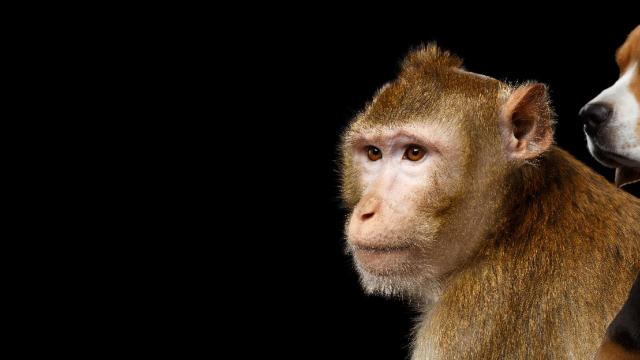One of the most common uses of dogs and monkeys is as a “second species” in tests for human medicines.
Following tests on rodents, drug companies are expected by regulators to also test on another species of animal—typically a dog or monkey, sometimes a mini pig or another species. We think this is flawed science and must be ended:
- The requirement to test on a second species has become “locked in”, yet it is not based on any strong scientific evidence
- Despite the requirement to test new drugs on two species, over 90% still fail in human clinical trials, often because they are unsafe or ineffective
- Our research has shown that using dogs, rats, mice and rabbits to test whether or not a drug will be safe for humans provides little statistically useful insight. Drug tests on monkeys are no better than other species in predicting the effects on humans
- Dogs and monkeys are extremely intelligent and sensitive animals. There is evidence that dogs have the emotional intelligence equivalent to a 3 year old child. We would not subject children to brutal experiments, so why do we do it to monkeys and dogs?
What we are doing
Our pioneering research, which demonstrates that using a second animal species in toxicity tests gives no additional insight into whether a new medicine is safe for humans, is helping lead the way to ending tests that use two different species. This would save many thousands of animals and expedite a shift to more human-relevant tests. We are building on this research to encourage regulators to change their requirements around the world.
Over 200,000 dogs
are estimated to be used in tests worldwide, every year.
Over 90,000 monkeys
are estimated to be used in tests worldwide, every year.
142 dogs
were used in the EU to test chemicals, pesticides and weedkillers in 2018.
Achievements
Our analysis of the use of animals in drug toxicity testing, which calls into serious question the scientific value of using animals to test the safety of new drugs for humans, was replicated in 2020 by the NC3Rs—a UK government body who worked with pharmaceutical companies. They concluded that “there are opportunities to use one species for studies of 13 to 39 weeks duration for a wider range of drug modalities than currently permitted within international regulatory guidelines.
We are calling for regulators to now seriously look into their requirement to test on two species for each new drug and to make recommendations.
Support our campaigns
End the trade in primates
subtitle: Thousands of monkeys are traded globally for research



